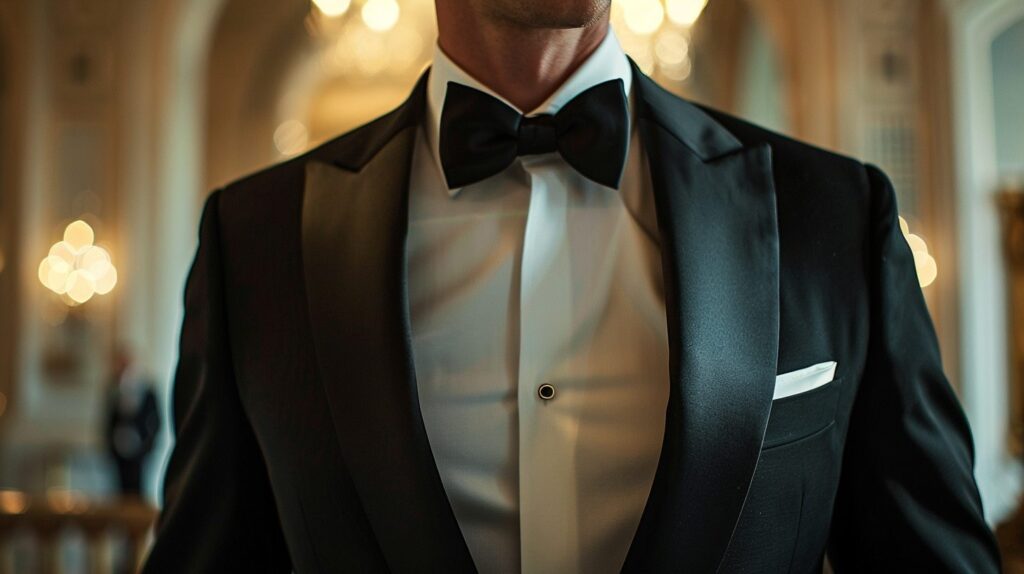Every man faces the question — suit or tuxedo? Both command respect, but each tells a different story.
A suit offers versatility and timeless appeal, perfect for business or semi-formal events. A tuxedo, on the other hand, exudes sophistication — made for moments that demand elegance.
Imagine walking into an event knowing your outfit matches the mood perfectly — sharp, confident, and unforgettable. Choosing the right one elevates not just your look, but your presence.
Learn the key differences and discover which style fits your personality and occasion best. Choose wisely — your look speaks before you do.
Here’s What You’ll Learn:
- What sets a Suit vs Tuxedo apart and why those details matter.
- The key design differences — from lapels and trousers to shirts and accessories.
- When to wear a tuxedo for formal black-tie events and when a suit fits better.
- How history shaped the modern tuxedo and suit we wear today.
- Tips on choosing the right fit and style for comfort and confidence.
- Common mistakes to avoid when dressing for business, weddings, or evening occasions.
What Is the Difference Between a Suit and a Tuxedo?
When it comes to Suit vs Tuxedo, the difference lies in the details. At first glance, they look similar, but their design and purpose set them apart.
A tuxedo is formal and typically worn at evening or black-tie events, while a suit is versatile—fit for business, weddings, and semi-formal occasions. Understanding these small differences helps you pick the right look for every event.
Defining Tuxedos and Suits
What Is a Tuxedo?

A tuxedo, also called a dinner suit, features satin details—on the lapels, buttons, and trouser stripes. It’s paired with a crisp white dress shirt, bow tie, and polished patent shoes.
This style is perfect for black-tie weddings, formal galas, or proms where elegance is key.
What Is a Suit?

A suit is a matching jacket and trousers made from the same fabric and color, without satin details. It can be dressed up with a tie or worn casually with an open-collar shirt.
Suits are practical for business meetings, daytime weddings, and semi-formal occasions—offering endless color and fabric options like navy, charcoal, or beige.
Historical Background
The Evolution of the Tuxedo
The tuxedo originated in late 19th-century England as a relaxed version of the tailcoat. It became the standard for black-tie wear after being introduced to New York’s Tuxedo Park—where it got its name.
The History of the Suit
The suit has been around since the 1600s and evolved into the modern symbol of professionalism. Today, it’s the go-to outfit for work, weddings, and other refined occasions.
Design and Fabric Differences
Trousers: Stripes vs. Plain
Tuxedo trousers have a satin stripe along the side, while suit trousers are plain and often worn with a belt.
Jacket Lapels: Satin vs. Fabric
Tuxedo jackets feature satin lapels in shawl, peak, or notch styles. Suit lapels match the jacket fabric, giving a cleaner, more versatile look.
Shirt Styles
Tuxedos are paired with pleated or studded shirts for formality. Suits use standard dress shirts, plain or patterned, for flexibility.
Accessories
Tuxedos call for a bow tie, cummerbund, and patent leather shoes. Suits allow variety—regular ties, leather shoes, and pocket squares for personality.
Common Mistakes to Avoid
❌ Wearing a tuxedo during the day — it’s for evening use.
❌ Mixing tuxedo jackets with suit trousers.
❌ Ignoring the dress code — tuxedo for black-tie, suit for business.
❌ Over-accessorizing — keep it sleek and classic.
Tuxedo or Suit? Know the Right Occasion
Wear a tuxedo for black-tie or formal evening events like weddings, galas, or proms. Stick to black or midnight blue for timeless appeal.
A suit is better for daytime weddings, interviews, and business meetings—offering comfort and versatility.
How a Suit Should Really Fit
🧥 Shoulders
The jacket should rest flat and line up perfectly with your shoulders. Avoid sagging or tightness to keep the shape clean.
👕 Sleeves & Trousers
Your jacket sleeve should show about half an inch of your shirt cuff. Trousers should lightly touch the top of your shoes for a neat finish.
⚖️ Waist
A slight taper at the waist creates a sharp, tailored look that flatters your body shape.
💨 Comfort
You should be able to move, sit, and raise your arms easily. A good fit looks stylish and feels comfortable all day.
Key Factors to Consider When Choosing Between a Suit and a Tuxedo
🎯 Occasion: Tuxedo for black-tie; suit for business or weddings.
🌇 Time of Day: Tuxedos for evening, suits for daytime.
👔 Style Preference: Tuxedos for timeless elegance; suits for modern versatility.
💰 Budget: Suits are more practical and affordable for frequent wear.
Tuxedo or Suit? The Decision
🤵 Choose a Tuxedo if you want a refined, timeless look for formal evening events like black-tie weddings, galas, or elegant dinners. Tuxedos have satin details that add a touch of luxury and sophistication.
👔 Choose a Suit if you prefer versatility and comfort. Suits work well for business meetings, job interviews, or daytime celebrations. You can dress them up or down depending on the occasion.
At the end of the day, the Suit vs Tuxedo choice comes down to confidence, comfort, and context. Whether you’re dressing for a wedding or prom, the right fit and style always speak louder than the label.
Tuxedo vs. Suit: FAQ Guide
1. What is the main difference between a suit and a tuxedo?
A tuxedo has satin lapels and buttons; a suit doesn’t. Tuxedos are for formal evening wear, suits for business or daytime events.
2. Can I wear a suit to a black-ttie event?
Not usually. Black-tie calls for a tuxedo. But if it says “optional black-tie,” a dark, tailored suit can work.
3. Is a dinner suit the same as a tuxedo?
Yes — “dinner suit” is the British term for a tuxedo.
4. What’s the difference between a dinner suit and a business suit?
A dinner suit (tuxedo) is formal evening wear; a business suit is for professional daytime settings.
5. How do I choose between a suit and tuxedo for my wedding?
Go for a tuxedo for an evening or black-tie theme; choose a suit for a daytime or semi-formal celebration.
